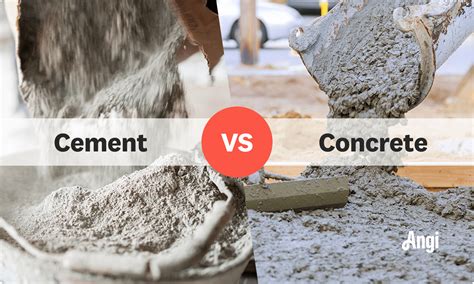When it comes to construction, two terms are often used interchangeably, but incorrectly so: concrete and cement. While both are essential components in the building process, they are not the same thing. In this article, we will delve into the world of construction materials, exploring the differences between concrete and cement, their unique properties, and their applications. By understanding the distinctions between these two fundamental materials, builders, architects, and engineers can make informed decisions about their projects, ensuring structures that are both durable and aesthetically pleasing.
Key Points
- Concrete and cement are not the same, despite often being used interchangeably.
- Cement is a primary ingredient in concrete, acting as a binder.
- Concrete is a composite material made from cement, water, and aggregate (such as gravel or sand).
- The properties of concrete, such as strength and durability, can be tailored by adjusting the mix design.
- Understanding the differences between concrete and cement is crucial for selecting the appropriate material for construction projects.
Understanding Cement

Cement is a fine powder made from limestone, clay, sand, and other minerals, which are crushed, mixed, and then heated to high temperatures in a kiln. This process, known as calcination, transforms the raw materials into a binding agent that hardens when mixed with water. The most common type of cement used in construction is Portland cement, named after the Isle of Portland in England, where it was first produced. Portland cement is a hydraulic cement, meaning it sets and hardens due to a chemical reaction with water, rather than simply drying out.
Cement Production Process
The production of cement involves several steps, including mining, grinding, and calcination. The raw materials are first quarried and then ground into a fine powder. This powder is then mixed with other ingredients and fed into a kiln, where it is heated to temperatures of up to 1450°C. The resulting clinker is then cooled and ground into the fine powder known as cement. The entire process requires careful control of temperature, pressure, and composition to produce cement with the desired properties.
| Type of Cement | Properties |
|---|---|
| Portland Cement | General-purpose cement, high strength, and durability |
| Blended Cement | Combines Portland cement with other materials, such as fly ash or silica fume, for improved workability and sustainability |
| Specialty Cement | Designed for specific applications, such as high-temperature resistance or low heat of hydration |

Understanding Concrete

Concrete, on the other hand, is a composite material made from a mixture of cement, water, and aggregate (such as gravel or sand). When the cement is mixed with water, it forms a paste that binds the aggregate together, creating a strong and durable material. The properties of concrete, such as its strength, durability, and workability, can be tailored by adjusting the mix design, including the type and amount of cement, water, and aggregate used.
Concrete Mix Design
The mix design of concrete is critical in determining its performance and suitability for a particular application. The American Concrete Institute (ACI) provides guidelines for mix design, taking into account factors such as the type of cement, the water-cement ratio, and the amount and type of aggregate. A well-designed mix can ensure that the concrete has the required strength, durability, and workability for the intended use.
For example, a mix design for a high-strength concrete might include a higher proportion of cement and a lower water-cement ratio, while a mix design for a self-consolidating concrete might include a higher proportion of aggregate and a specialized admixture to improve workability.
What is the difference between concrete and cement?
+Concrete is a composite material made from cement, water, and aggregate, while cement is a primary ingredient in concrete, acting as a binder.
What are the main types of cement used in construction?
+The main types of cement used in construction are Portland cement, blended cement, and specialty cement.
How can the properties of concrete be tailored for specific applications?
+The properties of concrete can be tailored by adjusting the mix design, including the type and amount of cement, water, and aggregate used.
In conclusion, while cement and concrete are often used interchangeably, they are distinct materials with different properties and applications. By understanding the differences between these two fundamental materials, builders, architects, and engineers can make informed decisions about their projects, ensuring structures that are both durable and aesthetically pleasing. Whether it’s a high-rise building, a bridge, or a simple patio, the choice of cement and concrete can have a significant impact on the performance, sustainability, and beauty of the final product.
